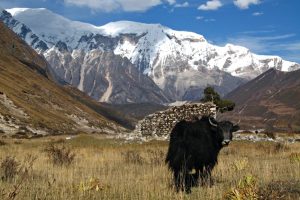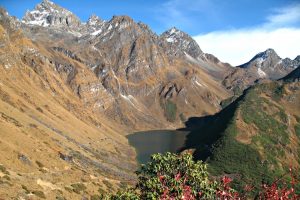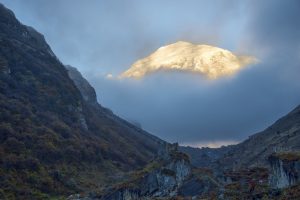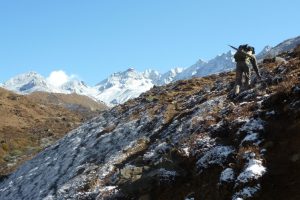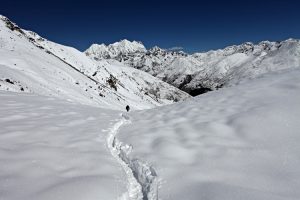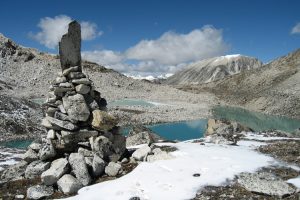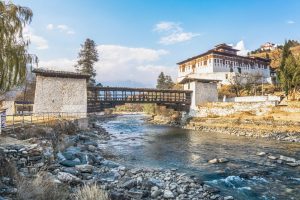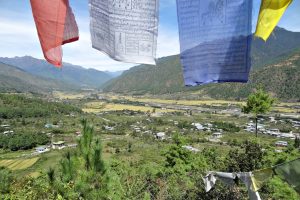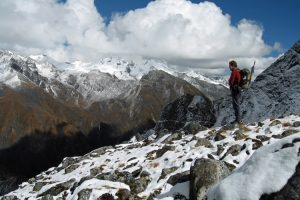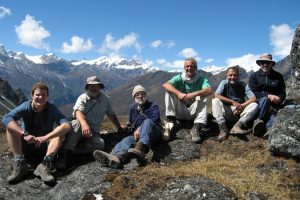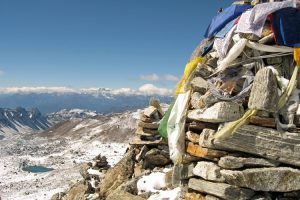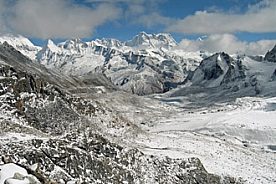
- Grade:
-
?
Strenuous
Suitable for fit individuals who have regular experience of mountain walking.
Find out more...
Strenuous
-
?
- Duration: 36 days from the UK
- On trek: 28 days Walks on: 1 day
- Private Departures Available
Flight inclusive from £13815, Land only from £12490
The longest, remotest and undoubtedly most epic trek in the Himalaya crossing 14 high mountain passes on a spectacular journey through Laya, Lunana and beyond.
Highlights
- The classic Snowman trek with a superb hike out through uncharted terrain
- Travel with a highly experienced Mountain Kingdoms leader supported by a Bhutanese guide and crew
- Excellent acclimatisation with carefully placed rest days in the best locations for exploration
- Sightseeing in Paro and Punakha including the walk to Tiger's Nest Monastery
- Two nights getting to know the people of Laya with their unique dress and cultural traditions
- First-rate camping on trek and a four-star hotel in Kathmandu
Treks don’t come any more remote and demanding than this! Nor more rewarding. Led by a highly experienced western leader, it takes you through fabulous country with high passes to cross virtually every day and an astonishing array of breathtaking scenery from first step to last.
Although this is a long trek, it is a fabulous challenge and we feel that this is one of most ‘special’ treks. Leaving civilisation behind we head north into the towering peaks of the Bhutan Himalaya, crossing 14 high passes and journeying through some of the most inaccessible human settlements on earth. After trekking past Bhutan’s second highest peak, Chomolhari, 7,314m/23,999ft, the route takes us through fabulous mountains and uninhabited areas to reach the village of Laya. From here we strike east again into Lunana, without doubt, the most remote region in Bhutan – even the King has only very recently visited it. It is closed throughout the winter by snowbound passes and indeed the lowest pass to enter Lunana is 5,029m/16,500ft. It is no mean achievement and few people have managed this journey. This route into Lunana is of course the natural continuation of our Lingshi Laya Trek, thus completing a traverse of the northern border with Tibet and thereby seeing all the un-named, unclimbed, unmapped Bhutanese peaks between 6,010m/20,000ft and 7,300m/24,000ft.
From Lunana we gradually make our way back to civilsation on a new route pioneered by our MD, Steve Berry. It is a stunning exploration through a wonderfully wild landscape, and a fitting close to an exceptional trek.
Mountain Kingdoms has been running the Lunana Snowman Trek for almost 30 years, and every departure has succeeded in its objectives. Logistical issues are not unusual given the challenging nature of this trek, and this success is due to a well measured itinerary which allows for flexibility, and most importantly, to the critical presence of an experienced western leader.
If you have any questions about this Lunana trek, then please contact Steve Berry 0044 (0)1453 844400.
Private Departures
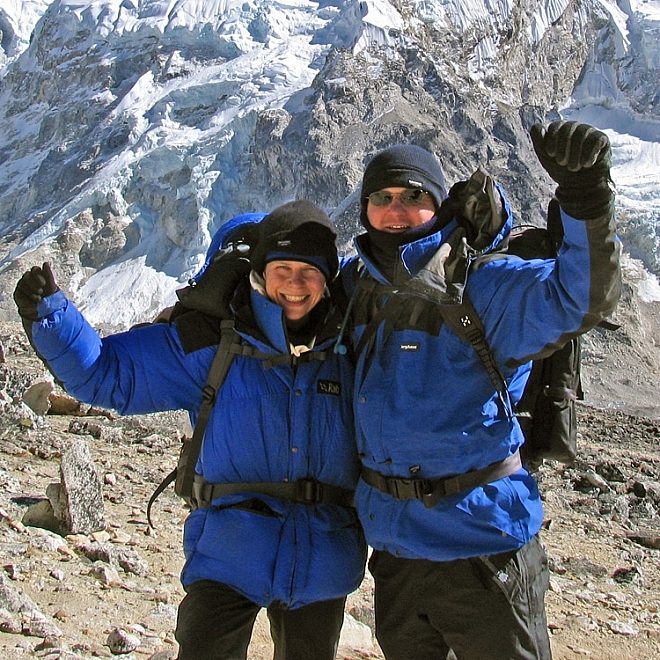
Lunana Snowman Trek Bhutan - Private Departures
If you would prefer to travel just with your partner, friends or family, we can arrange a private departure of this holiday. You follow the same itinerary, but travel on dates that suit you. Alternatively we can include elements of this holiday in a bespoke Tailor Made itinerary. Contact our friendly team for details and prices, and to make a booking.
At a glance
Strenuous
Duration: 36 days from the UK
On trek: 28 days Walks on: 1 day
Max. Altitude: 5,454m/17,894ft, Gophu La Pass, Day 24
Private Departures Available
Guaranteed to run for a minimum of 6 clients
Maximum group size: 12
Accommodation types: Hotels, Camping
Meal arrangements: Bed and Breakfast in Kathmandu, all meals in hotels and on trek in Bhutan.
Itinerary overview
| Day | Activity |
|---|---|
| 1-4 | Fly to Kathmandu and then to Paro in Bhutan. Sightseeing in the Paro Valley and walk to Taktsang Monastery. |
| 5 | Trek to Kyichu, drive to Gunitsawa, short walk to Shana. |
| 6-8 | Trek to Soi Thangthanka and Jangothang. Rest and acclimatisation day. |
| 9-10 | Cross the Nyele La Pass to Lingshi and trek to Chebisa. |
| 11-12 | Trek to Robulathang across the Gobu La and Jarela Pass. |
| 13-15 | Trek across the Shingela to Laya. Day to rest and explore the village. |
| 16-17 | Trek to Rodhophu, cross the Tsome La. Camp below Gangla Karchung. |
| 18-19 | Cross the Gangla Karchung La, to reach Tarina then Woche. |
| 20-22 | Trek to Lhedi across the Kashe La Pass and to Thanza for a rest day. |
| 23-24 | Cross the highest pass, the Gophu La, 5,243m/17,200ft, to reach Geche Woma. |
| 24-28 | Trek to Meluthang via Sachu Kheti and Demsho Wom. Rest day. |
| 29-32 | Trek to Padim, cross the Khemi La Pass and end trek at Sephu. Drive to Punakha. |
| 33-36 | Drive to Paro. Fly to Kathmandu. At leisure. Fly to London. |
Leader: Chris Darby
Chris is a doctor with an interest in high altitude medicine. He has considerable climbing and walking experience in the UK and the Alps, as well as leading treks and trekking peaks for us in Nepal, India and Tibet. Chris has summited Huascaran Norte in Peru (6,664m)and Cho Oyu, the sixth highest peak in the world at 8,200m. In 2012 Chris took a rest from expeditions and did the Iron Man Zurich Triathlon instead. Chris then led our challenging K2 and the Gondogoro La trek in 2017 and travelled with our MD, Steve Berry, to Morocco in 2020.
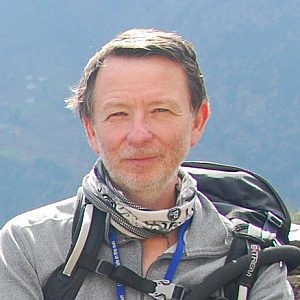
Holiday Itinerary
Day 1 - Fly London to Kathmandu
Depart London on your overnight flight to Kathmandu.

Day 2 - Arrive Kathmandu. Group transfer to hotel.
You will be met on arrival and transferred to your hotel. You might like to venture out to Thamel for your evening meal, or eat in the hotel restaurant if you are tired from your journey.

Day 3 - Fly to Paro, 2,250m/7,380ft. Sightseeing as time permits.
Transfer for the morning flight to Paro, the country's only airstrip. The flight often gives fantastic views of the Himalaya, including Everest, Lhotse, Makalu and Kangchenjunga. Particularly exciting is the section through the Bhutanese foothills and the thrilling landing. Try to sit on the left-hand side of the plane. On arrival you will be met by your Bhutanese Guide. It's useful to pick up a SIM card at the airport before you head off.
You should have time to look around Paro this afternoon including a visit to the dzong and museum. There may even be an archery competition in the town.

Day 4 - Walk to Taktsang Monastery. Visit Kyichu Lakhang.
Today you will walk up to the famous 'Tiger's nest', Taktsang Monastery, perched some 2,000ft/609m up on a cliff overlooking the Paro valley and one of the iconic buildings of Bhutan. It is said to be the spot where the legendary Indian saint, Guru Padma Sambhava flew from Tibet on the back of a tiger to defeat five demons who were opposing the spread of Buddhism in Bhutan. This is a popular route so it is worth starting early to enjoy the solitude. The walk, which will provide good acclimatization, is quite steep and takes about 2-3 hours to go up - less to descend. You may choose to walk just as far as the tea house for fantastic views or climb to some prayer flags just above where the views are even better. If there is a particular religious gathering or VIP visit in progress, you will not be able to enter the Monastery but in any case it is worth climbing for a further half hour beyond the tea house to another viewpoint directly across from the monastery. If you are allowed to visit the temple itself you have to descend steeply from this viewpoint about 100m/330ft on steps, only to climb again to reach the temple where it clings to the rock face. It was built to be isolated!
You then descend to your vehicle and drive to a nearby restaurant for lunch. The journey back to Paro passes Kyichu. Here you will visit the ancient temple of Kyichu Lakhang, one of the oldest in Bhutan, which was one of 108 temples built by Songsten Gampo an important early Tibetan king, to pin down the Bon demon that was thought to hover over the whole of Tibet. You may also have time for further sightseeing when you return to Paro after your trek.

Day 5 - Trek to Kyichu, drive to Gunitsawa, short walk to Shana, 2,788m/9,147ft – 5-6 hours.
You leave the hotel and walk up through the hills to a village. Further along is a nunnery that you can visit with some of the oldest paintings you will see in Bhutan. You continue along forested ridges until you reach Kyichu Lakhang after about three hours of gentle trekking. Your guide will be in his trekking clothes today, not his national dress, so won't be able to take you inside, but you can enjoy the surroundings again. Your bus will then take you along the increasingly bumpy road towards Shana, perhaps stopping somewhere near Drugyel Dzong for a picnic lunch by the river. From the military camp at Gunitsawa, you will walk the last hour on the old path, whilst the vehicle continues on with your gear to the camp at Shana.

Day 6 - Trek to Soi Thangthanka, 3,586m/11,765ft - 7-8 hours.
The route follows the river in heavily forested country, with isolated farmhouses and plenty of wildlife. The Bhutanese advise you to walk in pairs as there are bears in this area. You pass a junction en route, where another path leads north over the Tremo La to Tibet. Spencer Chapman crossed the Tremo La in 1937 on his way to climb Chomolhari. This can feel a tough opening day given the altitude you are at, and especially if the undulating terrain is muddy. There are a couple of rustic stone tourist shelters and toilet blocks at the campsite as well as a basic shop and electricity if you are lucky.

Day 7 - Trek to Jangothang, 4,102m/13,458ft - 5-6 hours.
It is worth getting up early to photograph the dawn colours on Bhutan's second highest mountain, Chomolhari, which is framed at the end of the valley. After about an hour's walk, you slowly leave the forest line and gradually climb into a beautiful valley, passing Tengethang, a winter home of Yak herdsmen. There is a school here which you may be able to visit, the children enjoy it as much as you will. You should see lots of yaks today before you arrive at a large round hut, which is the base camp for Chomolhari. The 7,314m/23,997ft high mountain overlooks the camp and nearby there are the ruins of an old fortress, which used to guard Bhutan against Tibetan invasion. This is a shorter day than yesterday but you will be feeling the altitude. The camp area has another tourist shelter and basic shop.

Day 8 - Rest and acclimatisation day.
Today you will the have chance to acclimatise and walk up to the Tsho Pho Lakes at 4,350m. On the walk to the lakes it is not unusual to see blue sheep plus birds of prey, also keep your eyes peeled for Marmot. There are some yak herders' huts by the lakes and great views back towards Chomolhari and Jitchu Drake. In the afternoon there is time to relax. At some point your mules from Shana will return home to be replaced by yaks or mules coming down from Lingshi.

Day 9 - Trek to Lingshi, 4,001m/13,126ft, crossing the Nyele La Pass, 4,817m/15,804ft - 6-7 hours.
You will have a good day's walking today with spectacular views of several stunning Himalayan peaks, including Jitchu Drake, 6,850m/22,470ft, and Tsering Kang, 6,994m/22,946ft. You start climbing straight away and after some 3-4 hours reach the Nyelela Pass at an altitude of 4,817m/15,804ft. You pass yak herders' pastures and will see, if they are still in the area, their camps. Coming down to Lingshi there are the first views of a dzong atop its 600ft/183m high hill. The dzong is (just) standing despite being badly damaged by an earthquake. Camp is in the valley before and below the dzong near the huts where the workers repairing the dzong live. They are prisoners doing their time apparently, although remarkably friendly, and you should see them at work tomorrow as the path passes the dzong. They will undoubtedly wish you luck on your long trek.

Day 10 - Trek to Chebisa, 3,870m/12,697ft - 5 hours.
This is a magical day. Leaving Lingshi behind, you contour and climb gently to reach another delightful village, Gang Yul which is set right below a 300m/1,000ft cliff. Another hour's walking brings you to a lovely little valley with a huge waterfall at one end and the Shangri-la village of Chebisa, where you camp by the side of the river on the archery green in the middle of the village. Very leisurely walking today, with plenty of reasons and opportunities to linger. Chebisa is the first example you will see of a village that has benefitted from cordyceps. The houses are no longer mud huts but wonderfully large, ornate and well decorated structures. Cordyceps is a fungus that attacks and then grows on caterpillars above 3,500m in parts of the Himalaya. They are sold to the Chinese at around £10 a piece.

Day 11 - Trek to Shomuthang, 4,222m/13,852ft, crossing the Gobu La Pass, 4,349m/14,268ft - 5-6 hours.
A walk up to the chorten en route to the waterfall before breakfast is recommended for lovely early morning views of the valley. You will have quite a stiff climb up to the Gobula at 4,349m/14,268ft, before dropping to a deserted valley full of rhododendrons and beautiful autumn colours. The path continues to traverse between valleys, eventually arriving at a couple of yak herders' huts in the valley below the Jarela. There are a couple of options for camping here depending on the time and energy levels!

Day 12 - Trek to Robulathang, 4,152m/13,662ft, crossing the Jarela Pass, 4,635m/15,207ft - 7-8 hours.
There is now a long haul over the Jarela at 4,635m/15,207ft, where once again you get stunning all-round views and the mountain of Tsering Kang 6,994m/22,946ft. You drop steeply down a forest trail to the Tcharijathang Valley, where herds of takin are said to roam at certain times of the year. The river here is your first potential river crossing: there are usually 2 or 3 temporary logs across at a narrow point, however, if not, it is an easy crossing, well below the knee, but you might want to have your sandals with you. It is a short, steep 40 minute climb out of the valley onto a flat shelf where you camp in the most wonderful amphitheatre of mountains. The valley below is full of yak herders' huts and their animals.

Day 13 - Trek to Limithang, 4,118m/13,510ft, crossing the Shingela La, 4,912m/16,115ft - 6-7 hours.
This is one of the hardest, but most rewarding, days of the trek. You climb slowly up to the Shingela, which takes some 5 hours, to be rewarded with stunning views of mountains, including the spectacular Gangchentak 6,794m/22,290ft at the head of the valley. On a clear day, almost all the mountains on the northern border are clearly visible, 10-20 miles distant. Eagles, Griffin Vultures, Blue Sheep and yak abound in this area and on your descent you may once again see nomadic yak-herders. On the way down you will pass a glacial lake that recently burst through the moraine that contained it; the remains of the flood damage are still evident. You camp in a lovely spot by the river bank.

Day 14 - Trek to Laya, 3,812m/12,506ft - 4 hours.
You will have a relatively leisurely walk today alongside the river to reach the largest village on the trek, though the walk does entail quite a bit of ascent and decent and quite a stiff climb at the end. Laya is a large and prosperous town spread across the hillside. It has a large school, electricity, a phone signal and is now only a day from the roadhead at Koina. Unlike the village in Nepal though, there are no tourists, tea houses, cafes and only a couple of basic shops. The people of Laya are famous for their vertically striped yak-hair clothing and strange conical bamboo hats. The women wear their hair long and have a great deal of turquoise and jade jewellery. The features of the people are even more Tibetan/Mongolian than the Bhutanese who live in the central valleys. The rest of the day is spent at leisure or visiting the village. Good views of Masagang, 7,165m/23,507ft, and other peaks.

Day 15 - Rest day in Laya.
During your rest day there will be an opportunity to meet local people. Hot stone baths are also on offer, something not to be missed, and it is worth walking up to the top of the town for the views from the park benches up there. New pack animals will join you here. It is more common now to take mules from here through to the end of the trek from where they get back to Laya by road in horseboxes. This avoids the horsemen having to return back over the high passes as the winter snows come in.

Day 16 - Trek via Taksaka to Rodhophu, 4,206m/13,800ft - 7-8 hours.
A tough day made longer with the packing of a new set of mules and yaks. You descend from the village a long way down into the start of the gorge. Look out for the ancient wooden gateway leaving the village. It is an hour and a half to reach the small army post of Taksaka. After a further forty minutes down the gorge you turn left, 3,240m/10,630ft, and start to head east towards Lunana. This is the start of your journey to Lunana proper.
Turning east you gradually climb through forest to a clearing with the remains of an old hut. There may be nomads camped near here. In places the path is high above the valley floor and the herders have to take care with the mules. You proceed in and out of the tree line, all the time climbing gradually into a high altitude valley with an impressive river and rapids. Eventually, you enter a flat-bottomed valley ringed with rocky mountains and a ruined tourist shelter. This is camp! With the ups and downs, it is 1,000m of ascent from the checkpost: this is a long hard day and if the weather is inclement can be quite a challenge.

Day 17 - Cross Tsome La Pass, 4,709m/15,450ft, and trek to below Gangla Karchung La, 4,900m/16,076ft - 5-6 hours.
The path up here can look quite exciting, however it is far better than it looks and in 2019 a gang of workers were camped here, substantially improving the route. 2-3 hours walking brings you to a small pass called the Tsome La, 4,709m/15,450ft. You are now in a region that is totally remote and exceedingly beautiful and as the day wears on the views and remoteness become even more acute. After the pass the route crosses an undulating series of ridges and then contours around a large mountainside; you may see a yak herders camp below. On and on, closer and closer to Gangla Karchung, until it rises sheer in front of you. This is one of the few mountains in Bhutan that has been climbed - in this case by a French expedition. The campsite below the face is spectacular.

Day 18 - Cross the Gangla Karchung La, 5,156m/16,916ft, to Tarina, 3,919m/12,857ft - 6-7 hours.
A great day! The climb up to the pass is rewarded by wonderful views of the glacial lakes and Kang Bum, 7,100m/23,294ft, hemmed in by moraine dams at the head of the first of the Lunana valleys. These lakes are the source of the Po Chu and are like snakes twisting down the valley. The path then runs down through a wide belt of rhododendron with stunning views in all directions. It is a long descent, previously described as steep and slippery, though since 2019 is is a vastly improved path. A choice of various camp sites are available amongst stunted heather.

Day 19 - Trek to camp above Woche, 4,114m/13,599ft - 6 hours.
A pleasant walk down the valley past a clearing named Tarina. The valley is hemmed in by rock walls and rocky peaks on all sides. Every half mile, spectacular waterfalls come thundering into the valley with its pine clad hillsides. The valley itself is a mass of colourful heather, flowers, brushwood, with no sign of human habitation. Finally, there is a steep climb through the forest at the end of the valley and contouring round to the first Lunana village of Woche. Woche used to be a simple village where you might get a butter tea. It is now another 'cordyceps' village with large, beautifully painted timber houses that would be more at home in the Swiss Alps. You might enjoy lunch here and get to meet some of the locals tending the fields and their animals. Most of the children will at the Lunana School which you will pass tomorrow. The crew will probably want to push on to the foot of tomorrow's pass, another hour and a half. It is a beautiful, flat, grassy campsite on the far side of the river with plenty of grazing for the mules.

Day 20 - Trek to Lhedi, 3,728m/12,231ft, across the Kashe La Pass, 4,556m/14,947ft - 6-7 hours.
From the the camp site near the river there is a steep haul to cross the Kashe La, 4,556m/14,947ft. On the way you pass a sacred lake, a beautiful pea green colour. You shouldn't throw stones into this as it would anger the spirit of the lake. Continuing, there is a huge cairn of stones and prayer flags on the pass before walking down the other side quite steeply, to the little village of Tegar. Watch out for the very pretty chorten just before the village. A new path traverses left above the village slowly losing height towards the valley floor. There is a particularly exciting cantilever bridge over a roaring torrent coming down between two cliffs. This is now the main valley leading up to Thanza in the distance - the wind rattles through it and the vast flood plain is evidence of the 1994 moraine breach. Lhedi is a string of houses on a terrace high above the river, rock walls behind and terraced fields in front. There is space to camp just after the village on the archery course. The school is definitely worth a visit. Children come from the surrounding villages and board here. In mid-November the teachers are helicoptered out and the school shuts for winter.

Day 21 - Trek to Thanza, 4,126m/13,537ft - 4-5 hours.
Route descriptions vary massively on this section, mostly because of the chaos and route changes caused by the moraine dam burst. It is only really a four hour walk, though it is worth enjoying and stopping in Chozo. Firstly, you follow the river for several hours to a junction of valleys, the main river flowing out of a much higher plateau down through numerous rapids. Once into the upper valley it broadens right out flat, with the river forming lakes and broad reaches and shortly afterwards you arrive at the village of Chozo. This is the only village that has a dzong in Lunana, which is well worth a detour to take a peek at. The people of Lunana are very superstitious and have very strong beliefs in the spirits of seven Tibetan brothers who many hundreds of years previously were defeated in a battle in Tibet. Each of these spirits dwells in their own locality in Lunana. The most powerful, Chumna, lives in a wood near the dzong of Chozo.
Carrying on across the plain, assisted by the wind, (look out for the large area of rippled sand) you eventually reach another rise into an even higher upper valley. Here there is a big village split either side of the river. To the north are the rock-walls behind which is the 7,300m/24,000ft Table Mountain and to the south are more snowy mountains. Again the village people are friendly, although they see very few westerners. Thanza is the largest village in Lunana and there is always plenty of activity to watch. Most houses have solar panels, and there is a phone signal: the last now till you reach the roadhead.

Day 22 - Rest day in Thanza.
The rest day today will be well-earned and extremely welcome. You may wish to do a few personal chores before spending time wandering around the village, meeting people and discovering something of the hard way of life of these remote tribespeople. The next 3 days are the longest of the trek, and there is increasingly a trend to set off in the afternoon of the rest day to get 3 or 4 hours up the valley. Most groups prefer to have a full rest day followed by 3 long days, but your leader may want to make the decision based on the weather forecast and group fitness.

Day 23 - Trek to before Gophu La, stop at Tshorim, 5,225m/17,142ft - 7-8 hours.
You will climb steadily for an hour to a cairn, undoubtedly sad to be leaving Thanza, but full of excitement about crossing the Gophu La. Looking back down the valley, Chozo and its dzong can be picked out and as it is an early start, smoke will still be drifting off the roofs of all the houses in the villages below. You carry on now, up a valley, more rapids and minor waterfalls, towards a large, pointed rock peak at its head. Slowly, but surely you come opposite the granite mountain, to have lunch in a circular low stone wall shelter. Carrying on, the scenery becomes more magnificent, until you reach camp near a lake surrounded by snowy peaks. The last few hours can be tough, winding their way through moraines with no obvious end in sight. There are two campsite options depending on how you are progressing: the first before and the second below the lake. It will be very cold at night whichever you stop at, though stunning.

Day 24 - Cross the Gophu La, 5,454m/17,894ft, to Geche Woma, 4,625m/15,174ft - 8 hours.
This surely must be one of the most beautiful trek days anywhere in the Himalaya. Try to see the sunrise, as the pink colours on the high snows are really fabulous. It is, in fact, not far to climb to the main pass, skirting around the edges of lakes, which, on a still day, mirror the ice-fluted peaks that you are passing between. As you come to the Gophu La, the highest mountain in Bhutan, Gangkar Punsum, 7,550m/24,770ft, towers above the horizon. It seems to be a piece of earth elevated to a higher, purer plain and is completely dazzling. It is a very long and tiring descent through moraines and boulders to the valley floor which is still at 4,800m. There is a river crossing here with no bridge so you may get wet sandals. There are usually boulders to get across on but some may be below the surface of the water and slippery. The crew will help you here, but you will be tired so take your time. Geche Woma is the name of the camping place in the valley but actually ther are three different places you can camp spread out down the valley. Ideally you want to get to at least the middle site otherwise tomorrow becomes a very long day. Coming down into the valley look back and see a 'Rupert Bear' peak framed at the end - perfectly conical and if you are lucky, ringed with cloud. Enjoy the remoteness, this is a very wild setting.

Day 25 - Cross the Saga La pass, 4,930m/16,175ft. Trek to Sachu Kheti, 4,267m/14,000ft - 7-8 hours.
The path follows on down the valley now, completely uninhabited, before a track leads back up the hillside to a small plateau. From there it climbs for 45 minutes to the lunch spot. After a welcome rest you cross a small pass and wind down to some yak herder huts. You then cross a narrow defile, past a large slope of sand, perhaps part of the old Tethyan Ocean. Coming to the top of the slope you are faced with an amazingly beautiful lake, locked in by a circle of rocky peaks, with an impossible looking path contouring up and around to a col, the Saga La Pass. The views are wonderful from this very dramatic point. From here you drop down steeply but on an easy path to your campsite with cliffs and rocky peaks all around. You will have now passed the turning for Dur Hot Springs and the Bumthang exit, and will be breaking out into genuinely unexplored territory. This is a long day and could be split at the yak herder's hut if needs be.

Day 26 - Cross unnamed pass, 4,520m/14,829ft, trek to Demsho Wom, 4,520m/14,892ft - 4 hours.
A fabulous day as you strike out for a week into the mainly uninhabited stretch of mountains between you and the road head. There are many blue sheep in this area. From camp it is steeply, but easily, down for an hour to a bridge. Stop and enjoy watching the yaks cross over. It is now a lovely afternoon climbing slowly up to a small 'pass' above the camp at Demsho Wom. The climb takes about 3 hours stopping for lunch en route or having it in camp on arrival. As you get higher there is a great vertical cliff on your right. To your left is a stream cascading over the lip of a valley above and crashing down steep rapids. Looking back you can see the other side you have just descended, and the horizon is a line of snow peaks and cliffs. The granite ridges produce odd shaped towers, unusual spires, mushrooms of rock and great cantilevered flakes. There are the sounds of Himalayan pheasants and choughs, and rhododendron everywhere. You also get views of the Saga La Pass. The path contours improbably and rises to a small pass. Camp lies just below, next to the stream. A huge valley meanders off to your right with more intriguing peaks and cliffs. Spend the afternoon relaxing or exploring the surrounding valleys. There are several high viewpoints easily achievable.

Day 27 - Cross Demsho La pass, 4,848m/15,905ft, and continue trek to Tshering Dorji Yak Herder Camp (Meluthang), 4,425m/14,518ft - 6 hours.
What a day! Another big challenge. 45 mins from camp you come to a large lake, Demsho Lake, and above that two smaller lakes. Now you turn right for the pass which may be snow covered. In 2016 our group saw the tracks of fox and snow leopard and just near the pass they saw a small rodent-like creature with ears like small saucers. They also saw three deer sprinting across the snow. Below the pass is a huge, beautiful valley containing two big lakes, one behind the other. You are so far from civilisation now. The air is clean and clear and nature is completely unspoilt. A magical place. From the end of the second lake you come to a 'lip' in the valley which falls away below you. The stream is like a snake heading off into the distance. Further down you come to some hillocks on your left and behind one of these is a yak herder's summer hut belonging to Tshering Dorji and his wife Pem Dem. They live here for 7 months of the year. Pem's brother Namgay lives over the other side of the hill to the east. Camp below their hut. The river needs crossing to get to camp, but there are a couple of places where the boulders are so large they are like bridges.

Day 28 - Rest and exploration day.
You'll probably want to relax today, but if not then the ridges on either side of camp are easily achievable and offer great views.

Day 29 - Cross small pass, 4,360m/14,340ft, trek to Padim, 4,515m/14,813ft - 5 hours
A grand day! You leave the lovely camp at Meluthang behind with its yak hut on the hill and its resident ravens, and it is steeply downhill for less than an hour to a bridge. In 2019 we met a family camped here with their 70 yaks as they slowly made their way out to Sephu for the winter. We enjoyed butter tea and yak cheese with them. After this it is a steep zig zag climb of 250m for an hour to then follow a traverse around a bowl in the mountains which climbs to a 'pass' and a small cairn. There is then a slanting descent to above a most beautiful lake. It is hemmed in by mountains and granite cliffs and is a lovely colour of green. The path goes around the lake, but several hundred feet above it, eventually climbing up and out of this bowl with big drops below, to a level grassy platform. This platform gives the most wonderful views of the massive main valley stretching several days hard walking in either direction. Hugely impressive! The mountains you have passed through are stacked on the horizon. Leading off the main valley are many side valleys, and right opposite is the valley where Tshering Dorji, Pem Dem, their son Wangchuk and their herd of yaks live. Beyond their valley is the one Namgay lives in, and beyond that again are various other valleys that the herders from the Tongsa region inhabit in the summer. It is said that there is a path that leads to Gangkar Punsum heading north, but for humans only; it is too difficult for animals. That must be something!! After soaking up the view the path traverses around the mountainside to a small bowl with room to camp. If the weather is kind the sunset and sunrise from this eyrie are sensational.

Day 30 - Trek across the Khemi La, 4,572m/15,000ft, to below the Chachi La, 4,361m/14,308ft - 6-7 hours.
Worth getting up early for the fiery orange sunrise over the peaks to the east and north. A steep short path leads to a small unmarked pass, and then there is a very fine path to the left of the mountain leading to the Khemi La marked by a cairn and prayer flags. One hour to the pass. Fantastic views on both sides of un-named, un-climbed mountains on both sides of the pass in an un-known area. Our guide and our cook had been this way previously with friends and came upon a herd of thirty Takin here. It is now three hours to the river far below, 3,560m/11,680ft. As you get nearer the river there is a massive rock wall on your right. The bridge and the ferocious rapids stun and amaze, and lunch will probably be taken near here. Then it is a long ascent through giant moss encrusted rhododendron with a thundering stream to the left. A 565m climb brings you to a huge lake penned in by mountains, where the stream needs to be crossed on easy stepping stones. The sting in the tail is another forty minutes to a great camp above the lake. This is a popular yak herders' pasture and there are many stone shelters and enclosures here, though the herders will probably have already left after the summer months.

Day 31 - Trek to Maurothang, 3,682m/12,080ft, across the Chachi la pass, 4,638m/15,216ft - 6-7 hours.
Above camp is another lake which is traversed on the east to enter a small cwm. Half an hour to the lake, half an hour to the top of the cwm. Now the climb to the pass begins in earnest. The pass could well be snow covered. Again to reach the Chachi La Pass is about an hour from the head of the cwm turning right up what seems the least probable of routes out of the valley. Great exultation on reaching the pass, the last big crossing! Many a group photo is needed here, and for those with energy, the grassy slopes up to the right provide even better views looking back down. If there is snow on the pass then again you may well see evidence of wild animals. Wonderful, wonderful views and on a clear day you can see Gangkar Punsum and many, many of the biggest peaks on the border with Tibet. There is a great colossus of a black rock peak looming over the pass too. Now begins the big descent. An hour brings you above a lake fed by a stream in the shape of a serpent - with beautiful views and prayer flags it makes for a fine lunch spot. Civilisation approaches! First a summer village of 13 huts, and at the bottom of the valley another 7 huts. Then you reach a junction with the main path coming from Lunana. This is the route many parties use. Five and a half hours from last night's camp to this point. Fifteen minutes more and you reach the first shop, and another fifteen minutes to the first of a couple of campsite options at Maurothang.

Day 32 - Trek to Sephu, 2,672m/8,766ft - 5-6 hours. Drive to Punakha - 3½ hours.
The last day's trekking! It is a long walk down the valley, mainly through forest. The path is pretty 'bouldery' and focus is needed. After the first hour you cross the main river to the left bank. Another forty five minutes brings you to a rather odd pagoda. Several more bridges and forested paths lie ahead with ever increasing signs of human habitation. Finally, without warning, you come to the end of the trek at a tarmac road at the Wangchuck Centennial National Park sign and transport awaits.
All aboard the magic bus to hot baths, warm comfortable beds and beer in Punakha.

Day 33 - Sightseeing in Punakha. Drive to Paro - 4 hours.
You will have time in the morning to do a little sightseeing in Punakha. A visit to the dzong is a dazzling experience. It is one of the largest and oldest monastery fortresses in Bhutan and the history and legends surrounding it are fascinating.
In the afternoon you will drive over the Dochu La pass, and bypassing Thimphu, you will carry on to the Paro valley.

Day 34 - Fly to Kathmandu. Afternoon at leisure.
Again, a sensational take-off and scenic Himalayan flight, including views of Chomolhari that you trekked past. In Kathmandu, you transfer back to your hotel, with time to relax and reflect on your adventure.

Day 35 - At leisure. Group transfer to airport. Depart for London.
You will have time at leisure in Kathmandu today when you may do some sightseeing or shopping, or simply relax at your hotel. Later in the afternoon there will be a transfer to the airport for your overnight flight to London.

Day 36 - Arrive London.
Map
Map Key
-
 Airport
Airport
-
 Point of interest
Point of interest
-
 Mountain Peak
Mountain Peak
-
 Day walk in this area
Day walk in this area
-
 Flights
Flights
-
 Internal Transfers
Internal Transfers
-
 Trek
Trek
Loading...
Hold your place
Not quite ready to book? Why not call us on +44 (0) 1453 844400 to hold a no obligation place while you make up your mind?
Optional supplements
-
Single Room Supplement
From £260 -
Single Tent Supplement
From £750
No Surcharge Guarantee
No surcharges will be applied to your holiday after you book. Prices on this website are updated regularly. The Flight Inclusive holiday price, or Land Only holiday price, will be confirmed to you at the time you make your booking. There will be no surcharges after your booking has been confirmed.
Flight inclusive holidays
The 'flight inclusive' holiday prices shown on this website are based upon our preferred airlines and the best priced economy class fares we are able to secure at the time of publication.
We will be able to advise on fares with alternative airlines, upgrades to Business Class, and the options for flights from regional UK airports, please contact us for more details.
Booking your holiday
-
Deposit
From £400.00
For the majority of our holidays, a deposit payment of £400.00 per person is required to secure your place(s), however a small number of holidays require a higher deposit - please refer to the holiday itinerary for more details. If the holiday departs within 60 days, a deposit of £1,000.00 per person is required.
Book now!
- Book your small group holiday securely online – click the ‘Book’ button next to your chosen departure or visit our How to Book page
- Complete and return a Booking Form available to download here.
- Call us on +44 (0)1453 844400 and one of our travel specialists will talk you through the booking process.
What’s included
- A Mountain Kingdoms appointed western leader supported by an expert Bhutanese guide
- Leader carries a full medical kit and satellite phone and has access to our company doctor 24/7 in case of emergencies
- All flights between Kathmandu and Paro and domestic hotel/airport transfers
- Good standard 4* accommodation in Kathmandu on a twin share, bed and breakfast basis
- In Bhutan, good standard hotel accommodation in main towns and best available hotels in outlying towns, on a twin share, full board basis
- Bhutan visa and Bhutan departure tax
- The use of a good quality down jacket and sleeping bag (when travelling to Bhutan via Kathmandu)
- A free high-quality Mountain Kingdoms kit bag
- All camping facilities (twin share) and all meals on trek
- Camp staff to carry out all camp work
- A satellite phone is carried by your guide in case of an emergency
- All road transport by private vehicles
- Sightseeing where specified
- Economy class return air fares from the UK & UK Departure Tax (flight inclusive only)
- Single, timed group airport transfer for international flights on arrival and departure
- Carbon offsetting with the Ecoan Tree Planting Project (for clients taking our flight inclusive option)
What’s not included
- Travel insurance
- Visa fees for Nepal
- Lunch and evening meals in Kathmandu
- Optional trips
- Tips
Read holiday reviews by Mountain Kingdoms travellers.
Overall score: 4.8571428571429 (Based on 7 reviews)
The Bhutan-Snowman Trek is arguably the toughest trek in the world. Being conscious of the fact that Mountain Kingdoms have been successfully operating this trek for 2-3 decades gave me a high degree of confidence in their professionalism and ability to succeed. The Western Leader was well qualified, constantly engaging, and made sound decisions when necessary in conjunction with the Bhutanese Sirdar (e.g. postponing a rest day to avoid a bad snowstorm crossing the highest pass). He kept abreast of the group's progress including, importantly, the back markers, as well as the morale of individuals, which helped to maximise our teams’ chances of success. Whilst seemingly a small contribution, he took the trouble to carry chocolate bars to give us a welcome boost on conquering every high pass - much appreciated by all. The Bhutanese crew (including pack animal herders) were universally excellent and besides great meals, provided fantastic support to every one of us. Also not resting on their laurels, this was the first commercial Mountain Kingdoms group to trek the new exit route out of Lunana (across the mountains between Sake-la and Maurothang), featuring a truly memorable couple of days in unspoiled wilderness. It was somewhat fitting, that crossing the final high pass, the Chachi-La, we had the most amazing crystal clear views of the Eastern Himalayas along the border with Tibet, including the infamous Gangar Puensum, the highest unclimbed mountain on the planet. All our prayers came true that day. Put in perspective, the photos that we took that day were completely cloud-free, unlike many of those in the guide-books! Sincere thanks for an experience which I will never ever forget.
It is difficult in a few words to express how pleased we were for the very professional way the entire crew and Harry in particular treated us. We could not have wished for a better guide and crew. Everything was very professionally handled. We felt very safe and well treated by everyone.
This was a wonderful trip - very well organised and expertly run. The route to Bumthang was inspired - giving us a bit of extra challenge, hot springs and something a bit different to boast about.
Mountain Kingdoms' comment: Please note - this review was given on return from our Complete Lunana Snowman Trek itinerary. From 2018 we take a spectacular new route out of Lunana.
The thing I appreciated in you offering this trek is that you had the intention to do the complete trek and add quite a lot of extra days for bad weather etc. The other groups doing the trek were a lot more stressed to get things done.
Mountain Kingdoms' comment: Please note - this review was given on return from our Complete Lunana Snowman Trek itinerary. From 2018 we take a spectacular new route out of Lunana.
All organisational aspects were seamless and there seemed to be a real empathetic understanding of the cultures we visited. Mountain Kingdoms guides know their stuff and are dependable leaders.
Mountain Kingdoms' comment: Please note - this review was given on return from our Complete Lunana Snowman Trek itinerary. From 2018 we take a spectacular new route out of Lunana.
Extend your holiday
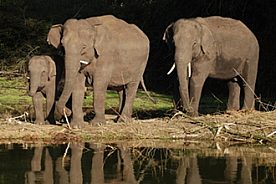
- Jungle activities including an elephant experience, bird watching, rafting and nature walks
- See wild elephant, rhinoceros, leopard, deer, wild boar and if you are lucky, the famous Royal Bengal Tiger
- Stay at the delightful Tiger Tops Karnali Lodge situated on the edge of the park
After your adventurous time in the Himalaya why not add a relaxing Jungle Safari to your trip? The Royal Bardia National Park is situated in the west of Nepal. We use Tiger Tops Karnali Lodge, which is acknowledged to be the best lodge in the area. Bardia’s remote geographic location and the fact that the lodge has only 12 rooms, lends a degree of exclusivity to the experience, in comparison to other more popular parks. From the lodge you will be able to participate in safaris and have the chance of seeing some of the country’s wonderful wildlife, for instance, wild elephant, rhinoceros, leopard, deer, wild boar and if you are lucky, the famous Royal Bengal Tiger. There is also the possibility of visiting the villages of the Tharu tribal people that surround the lodge. With its abundant wildlife, relaxing lodge and first class service, our Bardia extension is an experience you will savour!
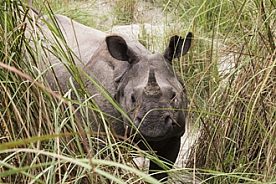
- Activities include; bird watching, elephant washing, canoe ride, elephant experience, landrover safari and jungle walks
- Choice of accommodation from budget to luxury
- Suitable to add to any holiday flying in/out of Kathmandu
Why not extend your adventure in Nepal by visiting Nepal’s jungle region for a complete contrast to the high mountains and the Kathmandu Valley. Chitwan is home to a rich and varied wildlife. Here are found wild elephant, rhinos, leopard, sambar, chital (spotted) deer, wild boar and arguably the most magnificent of cats, the Royal Bengal Tiger. You may even see sloth bear, gaur (wild cattle) and crocodiles. Chitwan is also wonderful for birdlife especially in the spring, when the jungle rings day and night to the calls of several kinds of Asian cuckoo.

- Escape the crowds and hustle and bustle of Kathmandu
- Walks available from the cottage - explore the nearby countryside
- Single and double rooms available, or exclusive hire of the entire cottage
- Breakfast and dinner included, plus unlimited tea and coffee
While in Kathmandu, why not experience an exclusive, private, home away from home? Shivapuri Heights Cottage is a “home-stay-style” property that offers a great escape from the hustle and bustle of the City. It is located in 2 acres of land at an altitude of 6,000ft /1,830m on the edge of the protected Shivapuri Reserve, with beautiful views looking down into the Kathmandu Valley.
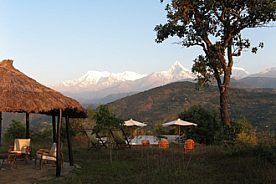
- Fly from Kathmandu to Pokhara in the Annapurna range of Nepal
- The lodge is an ideal base for you to relax in a rural mountain setting
- Beautiful outdoor swimming pool reflecting view of the Annapurna range
- Delicious Nepali dishes & continental specialities made from local fresh ingredients, home-grown herbs & garden salads
Why not extend your adventure in Nepal by visiting the beautiful Tiger Mountain Pokhara Lodge. Tiger Mountain Pokhara lodge is a lovely place, situated on a ridge half an hour outside Pokhara and enjoying the most stunning mountain views over the Annapurna range of mountains.
The lodge is an ideal base for you to relax in a rural mountain setting, away from the bustle of town. With a central lodge, bar and dining room, the comfortable rooms are arranged in clusters of cottages resembling a Nepali village. All have attached bathrooms, private verandas and Himalayan views. Daily menus feature a range of Nepali dishes as well as continental specialities made from local fresh ingredients and home-grown herbs and garden salads. You may enjoy lovely walks through the forests and villages of the lovely countryside surrounding the lodge, escorted by trained local guides. The beautiful swimming pool reflects the distant white peaks of the Annapurna range. The lodge also offers a range of Ayurvedic and shiatsu therapy and yoga and meditation sessions are also available (at additional cost). You may also venture further afield to visit Pokhara, Nepal’s second city located on a lovely lake and also enjoying spectacular views.
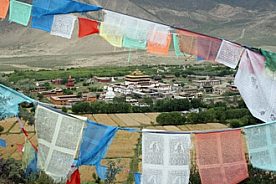
- Visit some of Tibet's most important historical and cultural sites and monasteries of Tibetan Buddhism.
- Offers a scenery completely different to that of Bhutan and Nepal.
- Suitable to add to any holiday flying in/out of Kathmandu.
A visit to Tibet offers an exciting extension to a visit to Nepal or Bhutan. Regular flights to Lhasa from Kathmandu make it possible to visit most of the major sights in and around Lhasa on an 8 day itinerary and a visit to Tibet will provide an exhilarating contrast to your trek or tour in Nepal or Bhutan. Tibet’s high plateau offers totally different and starker scenery to that of the other Himalayan countries. Here you will see some of the most important historical and cultural sites and monasteries of Tibetan Buddhism – the Potala Palace and Samye, Ganden and Drepung Monasteries.
If taking this extension you will need to spend an extra day beforehand in Kathmandu while our agents there process your Tibet visa. They will need your passport for the day for this purpose. You need to let us know in good time if you wish to take this extension as we need to put this process in hand and send your details to the Chinese Embassy in Kathmandu well before your departure date.
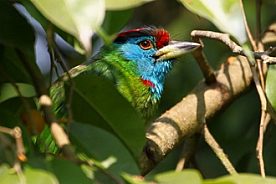
- Koshi Tappu is home to over 500 species of birds
- Look out for exciting wildlife like jungle cats, crocodiles and rare water buffalo
- Explore the park by foot, raft and jeep
- Stay in the pleasantly located Koshi Camp
Koshi Tappu Wildlife Reserve is one of the finest birdwatching and wildlife areas in all Asia. Located in south-east Nepal, the reserve covers 175 square kilometres with large expanses of open water created by the Koshi barrage, with marshes, lagoons, sandbanks and mudflats offering an outstanding wetland habitat. The reserve is home to over 500 species of birds, with the resident inhabitants being joined by large numbers of migratory species from Siberia and Tibet, which take up residence from November to February. The Koshi Tappu Wildlife Reserve provides one of the best places in Nepal to view migratory water fowl, waders and shore birds with many species seen here which are not recorded elsewhere in the region.
There is also much wildlife to be seen in Koshi Tappu including blue bull, golden jackal, Bengal fox, fishing cat, jungle cat, mongoose, civet cat, porcupine, Indian flying foxes and rare Gangetic dolphins as well as rare Marsh Mugger crocodiles. In addition, Koshi Tappu is the last habitat of the endangered Arna, a type of wild water buffalo.
During your visit you will explore the park with bird and animal spotting from a raft trip on the Koshi River, birdwatching walks, jungle walks and jeep trips. You will also have the opportunity to visit a family in one of the very interesting nearby local villages for a taste of rural Nepalese life. The Koshi Camp offers simple but comfortable accommodation and an expert staff of naturalists and birdwatchers to give you a comprehensive introduction to this wonderful area.
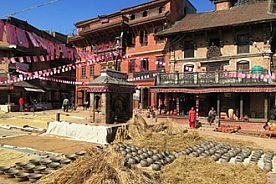
- Observe traditional crafts such as pottery, woodcarving and thangka painting
- Choose from a selection of full and half day guided tours
- Travel in a private car with a driver and an English-speaking guide
The Kathmandu Valley has a long and rich history and a vibrant culture and there is much that is worthwhile to see there - crowded bazaars, ancient temples, Buddhist stupas, crumbling shrines and picturesque palaces. The Malla kings who ruled in the valley created three major cities in the valley, Kathmandu, Bhaktapur and Patan and each of these cities has buildings that are showpieces for the art and architecture of local Newari craftsmen. We offer a selection of half day trips and full day trips to these sites the valley.
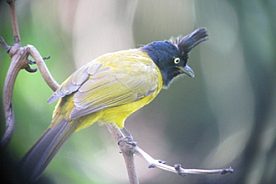
- Three full days at Royal Manas National Park - a birder's paradise
- Accommodation in a comfortable hotel close to the park, plus hotel nights en route
- Accompanied by an expert wildlife guide throughout
- Private transport, driver and all meals included
Extend your stay in Bhutan with time at the Royal Manas National park, a wonderful birder’s paradise close to the Indian border. Our extension package gives you three full days to explore the park and surrounding area, with all meals, private transport and comfortable accommodation included. You will be accompanied throughout by an expert guide to maximise your bird and wildlife viewing.



